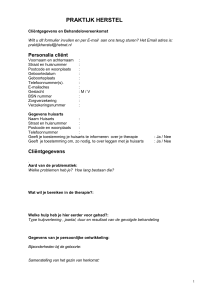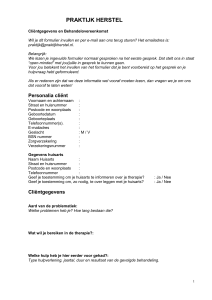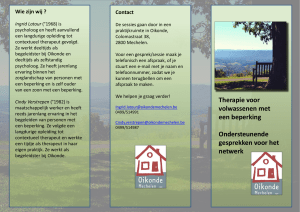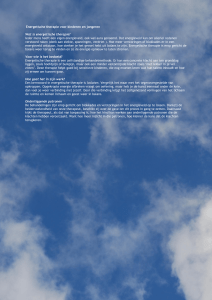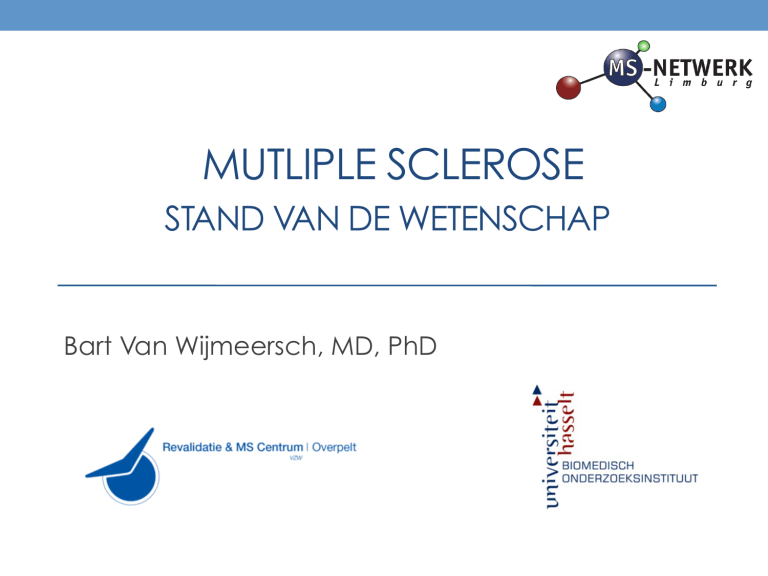
MUTLIPLE SCLEROSE
STAND VAN DE WETENSCHAP
Bart Van Wijmeersch, MD, PhD
Pathofysiologie
• Anatomopathologisch onderzoek
‘Etude anatomique et clinique sur la
sclérose en plaques’
J. Babinski 1885
Perivasculaire cuffs met inflammatie
Inflammatie = T, B, Mφ
Demyelinisatie (remyelinisatie)
Atrofie (axonaal verlies)
Pathofysiologie
• MS is an auto-immune demyeliniserende ziekte van het
centrale zenuwstelsel
• MS vertoont ook eigenschappen van een neurodegeneratieve
aandoening van het CZS
Pathofysiologie
symptomen
• 1 pathogenese, verschillende uitingen ?!
relapses
progressie
inflammatie
atrofie
Klinische
drempel
time
Pathofysiologie
symptomen
• 1 pathogenese, verschillende uitingen ?!
relapses
progressie
inflammatie
atrofie
Klinische
drempel
time
Pathofysiologie
• Verschillende MS verloopsvormen
Secondary progressive
Primary progressive
(15%)
Symptomen
Relapsing-Remitting
tijd
Pathofysiologie
‘de opflakkering’
‘relapse’
‘demyelinisatie’
‘ontsteking’
‘inflammatie’
Inflammatie & neurodegeneratie ?
- focale inflammatie
demyelinisatie)
groen (demyelinisatie witte stof)
oranje & blauw (grijze stof letsels)
- diffuse inflammatie
Zwarte stippen
(géén demyelinisatie)
= basis van neurodegeneratie
Kutzelnigg A, Lucchinetti CF, et al. Brain. 2005 nov
8
9
10
Belang van corticale letsels
• Komt beter overeen met de klinische aantasting
• Geheugen-problemen
• Aantal letsels vs klinische graad van aantasting
• Klassieke MRI beelden tonen slechts 20% van de corticale lestels:
nieuwe MRI technieken! (DIR en PSIR)
Belang van corticale letsels
• Rol van ‘meningeale inflammatie’ in deze letsels
• Hoe meer letsels, hoe meer atrofie (afsterven zenuwcellen)
Hersen-atrofie?
• Toch ook zonder inflammatie mogelijk?
• ‘innate immune system’
• ‘immuunsysteem’ aanwezig in de hersenen
• Het natuurlijke afweersysteem in de hersenen
• MICROGLIA
- In rust = protectief
- ‘geactiveerd’ bij gevaar
= ‘opruim activiteit’
Hersen-atrofie?
• Toch ook zonder inflammatie mogelijk?
• ‘steuncellen in de hersenen’
• ‘beschermen en voeden’ van zenuwcellen
• Component van de bloed-hersen-barrière
• ASTROCYTEN
- In rust = protectief
- ‘geactiveerd’ bij gevaar
= ‘mogelijk schadelijk’
Hersen-atrofie?
• Toch ook zonder inflammatie mogelijk?
• zenuwcellen of neuronen worden ‘metabool’ beschadigd
• Herstelbaar of onherstelbaar na stopzetten van ziekte?
• NEURONEN
Pathofysiologie
‘focale én diffuse ontsteking’
‘corticale demyelinisatie’
‘atrofie’
‘neurodegeneratie’
S/PPMS
RRMS
MS behandeling
WBC
WBC
WBC
Behandeling: RRMS
• DMD’s : ‘disease modifying drugs’
• Tegen inflammatie
• Immunomodulation
• Immunosuppressie
• Tegen neurodegeneratie
• Indirect: vroegtijdig schade voorkomen
• Indirect: door vroeg neuro-inflammatie te behandelen
• Direct: Neuroprotectiva? Endogeen herstel bevorderen?
Behandeling: RRMS
EERSTE-LIJNS THERAPIE
Interferon beta (1a,b) (Avonex, Betaferon/Extavia, Rebif)
Glatirameer acetaat (Copaxone)
• Gemiddeld 30% ARR reductie?
• Voor de patiënt telt de ‘Response rate’
• 1/3: non – responder
• 1/3: partial-responder
• 1/3: full-responder
Behandeling: RRMS
TWEEDE-LIJNS THERAPIE
• Indicatie:
1.
Falen van eerste-lijnstherapie (IFNbeta + relapse)
2.
Ernstige RRMS:
≥ 2 opflakkeringen in 1 jaar + MRI activiteit
20
Behandeling: RRMS
TWEEDE-LIJNS THERAPIE
symptomen
• Wanneer?
Window of Opportunity
klinische
drempel
tijd
21
Behandeling: RRMS
TWEEDE-LIJNS THERAPIE
Natalizumab (Tysabri)
- Blokkeren van migratie van lymphocyten over de BHB
Behandeling: RRMS
TWEEDE-LIJNS THERAPIE
Natalizumab (Tysabri)
- gemiddeld 68% reductie in ARR (AFFIRM: 2j studie vs placebo)
symptomen
Natalizumab
klinische
drempel
23
tijd
Behandeling: RRMS
TWEEDE-LIJNS THERAPIE
Natalizumab (Tysabri)
- 42% reductie van het risico op invaliditeitsprogressie na 2jaar
onder natalizumab vs placebo
Behandeling: RRMS
TWEEDE-LIJNS THERAPIE
Natalizumab (Tysabri)
92% ⇓
Gd+ letsels
83% ⇓
T2-hyperintense
letsels
76% ⇓
T1-hypo-intense
letsels
Behandeling: RRMS
TWEEDE-LIJNS THERAPIE
Natalizumab (Tysabri)
- PML (Progressive Multifocal Leucoencephalopathy)
- JC-virus encephalitis
Behandeling: RRMS
International TYSABRI Update SRL January 2013 - Data on file - www.biogenidec.ch
Behandeling: RRMS
2-3% /jaar
Sørensen P S et al. Mult Scler 2012;18:143-152
Behandeling: RRMS
TWEEDE-LIJNS THERAPIE
Fingolimod (Gilenya)
HO
OH
NH2
Sphingosine
HO
OH
Fingolimod
N H2
Behandeling: RRMS
S1P1R
Lymphocytes,
neural cells, EC
atrial myocytes, SMC
S1P3R
S1P4R
S1P5R
Neural cells, EC,
atrial myocytes, SMC
Lymphocytes
(low expression)
CNS,
oligodendrocytes,
natural killer cells
Effects
Lymphocyte
egress from
lymph nodes
Endothelial cell function,
vasomotor tone and
heart rate
CNS cell
function and
migration
Behandeling: RRMS
TWEEDE-LIJNS THERAPIE
A) No drug
B) Fingolimod treatment
Lymph
Node
High endothelial
venules
Lymphatic
endothelium
High endothelial
venules
Lymph
Node
S1P
Tn
S1P
Tn
S1P1
Loss of
CCR7
TEM
No requirement
for S1P signal
TCM
Loss of
CCR7
TEM
No requirement
for S1P signal
Efferent lymph
TCM
Blood
CCR7
Efferent lymph
Blood
CCR7
Lymphatic
endothelium
Behandeling: RRMS
TWEEDE-LIJNS THERAPIE
Fingolimod (Gilenya)
TRANSFORMS trial
FREEDOMS trial
ARR 54% tov placebo
30%
53%
Behandeling: RRMS
TWEEDE-LIJNS THERAPIE
Fingolimod (Gilenya)
Neveneffecten /Risico’s
•
Cardiale SP1P receptor leidt tot bradycardie (nadien internalisatie
•
Ophtalmologische controle na 3 maanden ter uitsluiting maculair oedeem
(vnl bij risico-patiënten: diabetes, iritis,..)
Bloedcontroles op maand 1, 3, 6, 9, 12 enz (leverfunctie en lymphocyten vnl)
Infecties (vnl herpesviridae: VZV, HSV, CMV, …)
•
•
receptoren op myocard waardoor slechts tijdelijk neveneffect)
Richtijnen:
• Minimaal 6u cardiale monitoring met ECG voor én na
• Cave andere bradycardiserende medicatie
• Bloeddruk stijgt met 2mmHg gemiddeld
Behandeling: RRMS
TOEKOMST Nieuwe Orale and IV therapie
Behandeling: RRMS
TOEKOMST
Alemtuzumab (Lemtrada)
• Anti-CD52 monoclonal Ab
• Depletie van T en B lymfocyten (NK, mono’s)
CD52
T&B
lymphocytes
• ‘Heropvoedings-hypothese’en ‘Tijdelijk Treg overwicht’
• 1x per jaar IV (12mg/d 5 dagen; 2e jaar 3dagen )
Behandeling: RRMS
TOEKOMST
Alemtuzumab (Lemtrada)
Recovery
at ~6 months
CD19+
B cells
CD4+
T cells
LLN by
~12 months
Behandeling: RRMS
Study duration (months)
0
12
Daily
x5
Daily
x3
24
Alemtuzumab
12 mg IV
Randomized
2:1
IFNB-1a
44 µg SC
Treatment group
3x/week
CARE-MS I
CARE-MS II
N=581
N=840
SC
IFNB-1a
Alem 12
mg/d
SC
IFNB-1a
Alem 12
mg/d
36.1
22.8
31.2
34.2
3.5
34.3
28.2
36.2
34.3
3.5
Prior therapy, %
SC IFNB-1a (22 or 44 µg)
IM IFNB-1a
SC IFNB-1b
Glatiramer acetate
Natalizumab
--
--
Duration of prior therapy, mo
--
--
36 (23.7)
35 (25.0)
EDSS score
2.0 (0.8)
2.0 (0.8)
2.7 (1.2)
2.7 (1.3)
Disease duration, yr
2.0 (1.3)
2.1 (1.4)
4.7 (2.9)
4.5 (2.7)
Behandeling: RRMS
TOEKOMST
Alemtuzumab (Lemtrada)
49.4 %
p<0.0001
0.52
0.26
Years 0–2
Percentage of Patients with SAD
Adjusted ARR (95% CI)
CARE-MS II
HR: 0.58
p=0.0084
21.1%
42 %
12.7%
0
SC IFNB-1a
Alem 12 mg
3
6
9
12
15
18
Follow-up Month
21
24
Behandeling: RRMS
TOEKOMST
Alemtuzumab (Lemtrada)
Risico’s
- Infectieus
- Secundaire auto-immuniteit:
- Schildklierlijden (meestal hyper, soms hypo)
- Idiopathische Trombocytopene Purpura (ITP)
- Goodpasture’s syndrome (anti GBM nefropathie)
Behandeling: RRMS
TOEKOMST
Alemtuzumab (Lemtrada)
Risico’s
• Infecties
• Meestal mild tot matig, beantwoorden aan conventionele therapie
• Viraal (HSV, VZV, CMV) en soms oppervlakkig fungaal
Behandeling: RRMS
TOEKOMST
Alemtuzumab (Lemtrada)
Risico’s
• Secundaire Auto-immuniteit
• Schildklier
ME:
A
N
F
nctie
A
u
f
D
r
E
e
i
l
ildk
E BLO , schR/
S
• 16-30% Graves Type Hyperthyroïdie
conventioneel
K
J
I
NDEL ierfunctie
A
A
EM
T
H
en n
C
r
I
L
e
P
v
VER mule, le
• ITP
+ for
t
e
l
p
R/ conventioneel
m auto-immuun, ‘traag’, transiënt
c• o3%
• Goodpasture
• Zeldzaam: 1 casus in Fase II, geen in Fase III, 2 casussen buiten studies
Behandeling: RRMS
TOEKOMST
Teriflunomide (Aubagio)
Teriflunomide blokkeert proliferatie en functie van geactiveerde T en B cellen, door
selectief en reversiebel Dihydroorotate Dehydrogenase (DHODH) te inhiberen, en zo de
novo pyrimidine synthese te stoppen. Traag delende, rustende lymphocyten worden
niet beïnvloed.
Behandeling: RRMS
TOEKOMST
TERIFLUNOMIDE (Aubagio)
Behandeling: RRMS
TOEKOMST
TENERE trial
Time to treatment failure
Teriflunomide (Aubagio)
TEMSO trial
Non superior vs IFNb
Non inferior vs IFNb
Behandeling: RRMS
TOEKOMST
Teriflunomide (Aubagio)
Neveneffecten en Risico’s
• Alopecia (dunner worden van haar)
•
Diarrhee
Stijging van transaminasen
•
Gestegen urinezuur klaring: acute urinezuur nefropathie (zeldzaam)
•
•
Polyneuropathie (zeker bij ‘risicopatiënten’: vb diabetes) maar
zeldzamer dan bij leflunomide (Arava)
TERATOGEEN (zowel vrouw als man!!)
Eliminatie is traag door lange T ½
wash out door cholestyramine
active kool
•
Behandeling: RRMS
TOEKOMST
Dimethyl Fumaraat
Behandeling: RRMS
TOEKOMST
DEFINE study
n = 12373
Placebo
BG-12 240 mg t.d.s. (720 mg/day)
BG-12 240 mg b.d. (480 mg/day)
CONFIRM study
n = 14303
Placebo
BG-12 240 mg t.d.s. (720 mg/day)
BG-12 240 mg b.d. (480 mg/day)
GA 20 mg SC o.d.
(Reference arm; not powered for statistical comparisons of
non-inferiority or superiority)
Randomization
1 year
2 years
Behandeling: RRMS
TOEKOMST
Dimethyl Fumaraat
CONFIRM trial
DEFINE trial
34-38%
Behandeling: RRMS
TOEKOMST
Dimethyl Fumaraat
Neveneffecten en Risico’s
• Diarrhee
• Flushing
•
•
20-30% van de patiënten in de eerste maand na start !
Gemiddelde lymphocyten-aantal in bloed daalt met 28-32%
(nog boven LLN)
Besluit
• Relapsing Remitting MS
• Meer en betere medicatie
• Op maat afhankelijk van ernst
• Vroegtijdig starten
• Belang van corticale letsels…nieuwe technieken
• Streven naar ‘zero tolerance’
• Progressieve MS
• Begint al subklinisch
• Inflammatie gebonden, maar mogelijk ook zonder
• Rol van corticale/meningeale inflammatie
• Rol van natuurlijk afweersysteem (microglia, astrocyten)
FOCUS van toekomstig onderzoek naar behandelingen






